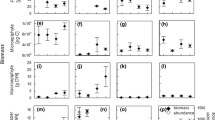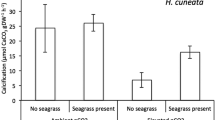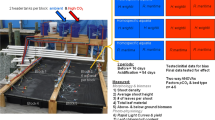Abstract
Climate change is driving species range shifts worldwide. However, physiological responses related to distributional changes are not fully understood. Oceanographers have reported an increase in ocean temperature in the northwest Iberian Peninsula that is potentially related to the decline in some cold-temperate intertidal macroalgae in the Cantabrian Sea, namely Fucus serratus. Low tide stress could also play a role in this decline. We performed one mensurative (in situ) and two manipulative (in culture) experiments designed to evaluate the interactive effects of some physical factors. The first experiment analysed field response to low tide stress in marginal (mid-Cantabrian Sea and northern Portugal) versus central (Galicia) populations of F. serratus. Then a second experiment was performed that utilized either harsh or mild summer conditions of atmospheric temperature, irradiance, humidity, and wind velocity to compare the responses of individuals from one marginal and one central population to low tide stress. Finally, the combined effect of sea temperature and the other factors was evaluated to detect interactive effects. Changes in frond growth, maximal photosynthetic quantum yield (F v/F m), temperature, and desiccation were found. Three additive factors (solar irradiation, ocean and air temperatures) were found to drive F. serratus distribution, except under mildly humid conditions that ameliorated atmospheric thermal stress (two additive factors). Mid-Cantabrian Sea temperatures have recently increased, reaching the inhibitory levels suggested in this study of F. serratus. We also expect an additive secondary contribution of low tide stress to this species decline. On the northern Portugal coast, ocean warming plus low tide stress has not reached this species’ inhibition threshold. No significant differential responses attributed to the population of origin were found. Mechanistic approaches that are designed to analyse the interactive effects of physical stressors may improve the levels of confidence in predicted range shifts of species.



Similar content being viewed by others
References
Abdala-Díaz RT, Cabello-Pasini A, Pérez-Rodriguez E, Conde Álvarez RM, Figueroa FL (2006) Daily and seasonal variations of optimum quantum yield and phenolic compounds in Cystoseira tamariscifolia (Phaeophyta). Mar Biol 148:459–465
Alonso-Alvarez C, Bertrand S, Devevey G, Prost J, Faivre B, Sorci G (2004) Increased susceptibility to oxidative stress as a proximate cost of reproduction. Ecol Lett 7:363–368. doi:10.1111/j.1461-0248.2004.00594.x
Altamirano M, Flores-Moya A, Figueroa FL (2003) Effects of UV radiation and temperature on growth germlings of three species of Fucus (Phaeophyceae). Aquat Bot 75:9–20
Arrontes J (2002) Mechanisms of range expansion in the intertidal brown alga Fucus serratus in northern Spain. Mar Biol 141:1059–1067
Arrontes J (2005) A model for range expansion of coastal algal species with different dispersal strategies: the case of Fucus serratus in northern Spain. Mar Ecol Prog Ser 295:57–68
Austin MP, Van Niel KP (2011) Improving species distribution models for climate change studies: variable selection and scale. J Biogeogr 38:1–8
Bell EC (1995) Environmental and morphological influences on thallus temperature and desiccation of the intertidal alga Mastocarpus papillatus Kützing. J Exp Mar Biol Ecol 191:29–55
Beniston M, Stephenson DB, Christensen OB, Ferro CAT, Frei C, Goyette S, Halsnaes K, Holt T, Jylhä K, Koffi B, Palutikoff J, Schöll R, Semmler T, Woth K (2007) Future extreme events in European climate; an exploration of regional climate model projections. Clim Change 81:71–95
Chapman ARO (1995) Functional ecology of fucoid algae: twenty-three years of progress. Phycologia 34(1):1–32
Christensen MR, Graham MD, Vinebrooke RD, Findlay DL, Paterson MJ, Turner MA (2006) Multiple anthropogenic stressors cause ecological surprises in boreal lakes. Glob Change Biol 12:2316–2322
Collén J, Davison IR (1999) Reactive oxygen production and damage in intertidal Fucus spp. (Phaeophyceae). J Phycol 35:54–61
Collén J, Davison IR (2001) Seasonality and thermal acclimation of reactive oxygen metabolism in Fucus vesiculosus (Phaeophyceae). J Phycol 37:474–481
Darling ES, Côté IM (2008) Quantifying the evidence for ecological synergies. Ecol Letts 11:1278–1286
Dat J, Vandenabeele S, Vranova E, Van Montagu M, Inze D, Van Breusegem F (2000) Dual action of the active oxygen species during plant stress responses. Cell Mol Life Sci 57:779–795
Davison IR, Pearson GA (1996) Stress tolerance in intertidal seaweeds. J Phycol 32:197–211
Denny MW, Hunt LJH, Miller LP, Harley CDG (2009) On the prediction of extreme ecological events. Ecol Monogr 79(3):397–421
Dethier MN, Williams SL, Freeman A (2005) Seaweeds under stress: manipulated stress and herbivory affect critical life-history functions. Ecol Monogr 75(3):403–418
Dromgoole FI (1980) Desiccation resistance of intertidal and subtidal algae. Bot Mar XXIII:149–159
Fernández C, Anadón R (2008) La cornisa cantábrica: un escenario de cambios de distribución de comunidades intermareales. Algas 39:30–32
Figueroa FL, Viñegla B (2001) Effects of solar UV radiation on photosynthesis and enzyme activities (carbonic anhydrase and nitrate reductase) in marine macroalgae from southern Spain. Rev Chil de Hist Nat 74:237–249
Fischer-Piette E (1957) Sur les progrès des espèces septentrionales dans le bios intertidal ibérique: situation en 1956–57. Ibidem 245:373–375
Gómez I, Figueroa FL, Ulloa N, Morales V, Lovengreen C, Huovinen C, Hess S (2004) Patterns of photosynthesis in 18 species of intertidal macroalgae from southern Chile. Mar Ecol Prog Ser 270:103–116
Gómez-Gesteira M, deCastro M, Alvaez I (2008) Coastal sea surface temperature warming trend along the continental part of the Atlantic Arc (1985–2005). J Geophys Res Oceans 113:C04010
Grinnell J (1917) Field tests of theories concerning distributional control. Am Nat 51:115–128
Häder DP, Figueroa FL (1997) Photoecophysiology of marine macroalgae. Photochem Photobiol 66:1–14
Hampe A, Petit RJ (2005) Conserving biodiversity under climate change: the rear edge matters. Ecol Lett 8:461–467
Harley CDG (2003) Abiotic stress and herbivory interact to set range limits across a two-dimensional stress gradient. Ecology 84:1477–1488
Harley CDG, Paine RT (2009) Contingencies and compounded rare perturbations dictate sudden distributional shifts during periods of gradual climate change. Proc Natl Acad Sci USA 106(27):11172–11176
Hawkins SJ, Sugden HE, Mieszkowska N, Moore PJ, Poloczanska E, Leaper R, Herbert RJH, Genner MJ, Moschella PS, Thompson RC, Jenkins SR, Southward AJ, Burrows MT (2009) Consequences of climate-driven biodiversity changes for ecosystem functioning of North European rocky shores. Mar Ecol Prog Ser 396:245–259
Helmuth B, Broitman BR, Blanchette CA, Gilman S, Halpin P, Harley CDG, O’Donnell MJ, Hofmann GE, Menge B, Srtickland D (2006) Mosaic patterns of thermal stress in the rocky intertidal zone: implications for climate change. Ecol Monogr 76(4):461–479
Huey RB (1991) Physiological consequences of habitat selection. Am Nat 137:S91–S115
Huppertz K, Hanelt D, Nultsch W (1990) Photoinhibition of photosynthesis in the marine brown alga Fucus serratus as studied in field experiments. Mar Ecol Prog Ser 66:175–182
Jones CG, Lawton JH, Shachak M (1994) Organisms as ecosystem engineers. Oikos 69:373–386
Jump AS, Hunt JM, Peñuelas J (2006) Rapid climate change-related growth decline at the southern range edge of Fagus sylvatica. Glob Change Biol 12:2163–2174
Kearney M, Porter W (2009) Mechanistic niche modelling: combining physiological and spatial data to predict species ranges. Ecol Lett 12:334–350
Lemos R, Pires HO (2004) The upwelling regime off the West Portuguese Coast, 1941–2000. Int J Climatol 24(4):511–524
Lima FP, Ribeiro PA, Queiroz N, Hawkins SJ, Santos AM (2007) Do distributional shifts of northern and southern species of algae match the warming pattern? Glob Change Biol 13:2592–2604
Livingstone DR (2001) Contaminant-simulated reactive oxygen species production and oxidative damage in aquatic organisms. Mar Pollut Bull 42(8):656–666
Llope M, Anadón R, Viesca L, Quevedo M, González-Quirós R, Stenseth NC (2006) Hydrography of the southern Bay of Biscay shelf-break region: integrating the multiscale physical variability over the period 1993–2003. J Geophys Res 111:C0921. doi:10.1029/2005JC002963
Lobban CS, Harrison PJ (1997) Seaweed ecology and physiology. Cambridge University Press, Cambridge
Lotze HK, Worm B (2002) Complex interactions of climatic and ecological controls on macroalgal recruitment. Limnol Oceanogr 47(6):1734–1741
Lüning K (1990) Seaweeds: their environment, biogeography, and ecophysiology. Wiley-Interscience, New York
Lushchak VI (2011) Adaptive response to oxidative stress: bacteria, fungi, plants and animals. Comp Biochem Phys C 153(2):175–190. doi:10.1016/j.cbpc.2010.10.004
Mac Nally R (2002) Multiple regression and inference in ecology and conservation biology: further comments on identifying important predictor variables. Biodivers Conserv 11:1397–1401
Maxwell K, Johnson GN (2000) Chlorophyll fluorescence—a practical guide. J Exp Bot 51(345):659–668
Michel S, Treguier A-M, Vandermeirsch F (2009) Temperature variability in the Bay of Biscay during the past 40 years, from an in situ analysis and a 3D global simulation. Cont Shelf Res 29:1070–1087
Nishiyama Y, Allakhverdiev SI, Murata N (2011) Protein synthesis is the primary target of reactive oxygen species in the photoinhibition of photosystem II. Physiol Plantarum. doi:10.1111/j.1399-3054.2011.01457.x
Paine RF, Tegner MJ, Johnson EA (1998) Compounded perturbations yield ecological surprises. Ecosystems 1:535–545
Parmensan C (2006) Ecological and evolutionary responses to recent climate change. Annu Rev Ecol Evol Syst 37:637–669
Pearson GA, Lago-Leston A, Mota C (2009) Frayed at the edges: selective pressure and adaptive response to abiotic stressors are mismatched in low diversity edge populations. J Ecol 97:450–462
Przeslawski RZ, Davis AR, Benkendorff K (2005) Synergistic effects associated with climate change and the development of rocky shore molluscs. Glob Change Biol 11:515–522. doi:10.1111/j.1365-2486.2005.00918.x
Schmidt-Nielsen K (2001) Animal physiology: adaptation and environment, 5th edn. Cambridge University Press, New York
Schreiber U, Endo T, Mi H, Asada K (1995) Quenching analysis of chlorophyll fluorescence by saturation pulse method: particular aspects relating to the study of eukaryotic algae and cyanobacteria. Plan Cell Physiol 36:873–882
Takahashi S, Badger MR (2011) Photoprotection in plants: a new light on photosystem II damage. Trends Plant Sci 16(1):53–60
Thomas CD, Cameron A, Green RE, Bakkenes M, Beaumont LJ, Collingham YC, Erasmus BFN, Ferreira de Siqueira M, Grainger A, Hannah L, Hughes L, Huntley B, van Jaarsveld AS, Midgley GF, Miles L, Ortega-Huerta MA, Peterson AT, Phillips OL, Williams SE (2004) Extinction risk from climate change. Nature 427:145–148
Underwood T (1997) Experiments in ecology. Their logical design and interpretation using analysis of variance. Cambridge University Press, Cambridge
Viejo RM, Martínez B, Arrontes J, Astudillo C, Hernández L (2011) Reproductive patterns in central and marginal populations of a large brown seaweed: drastic changes at the southern range limit. Ecography 34:75–84. doi:10.1111/j.1600-0587.2010.06365.x
Wegner KM, Kalbe M, Milinski M, Reush TBH (2008) Mortality selection during the 2003 European heat wave in three-spinde sticklebacks: effects of parasites and MHC genotype. BMC Evol Biol 8:124. doi:10.1186/1471-2148-8-124
Wernberg T, Thomsen MS, Tuya F, Kendrick GA, Staehr PA, Toohey BD (2010) Decreasing resilience of kelp beds along a latitudinal temperature gradient: potential implications for a warmer future. Ecol Lett 13:685–694
Acknowledgments
We would like to thank L. De Hond and A. Marhadour for their linguistic assistance. BM, FA, RMV, FLF, and JIGP are grateful for the financial support of the Ministry of Education and Science of Spain (projects HP2007-0081, CGL2007-66095, CGL2008-05407, CGL2010-19301, and BFU2010-15021), the Fundação para a Ciência e a Tecnologia (FCT) of Portugal (project PTDC/MAR/105147/2008 co-funded by FEDER through the programme COMPETE-QREN), and the Basque Government (UPV/EHU-GV IT-299-07). We would also like to thank the handling editor A. Underwood, and two anonymous reviewers for their very helpful review of the manuscript.
Author information
Authors and Affiliations
Corresponding author
Additional information
Communicated by Tony Underwood.
Rights and permissions
About this article
Cite this article
Martínez, B., Arenas, F., Rubal, M. et al. Physical factors driving intertidal macroalgae distribution: physiological stress of a dominant fucoid at its southern limit. Oecologia 170, 341–353 (2012). https://doi.org/10.1007/s00442-012-2324-x
Received:
Accepted:
Published:
Issue Date:
DOI: https://doi.org/10.1007/s00442-012-2324-x




